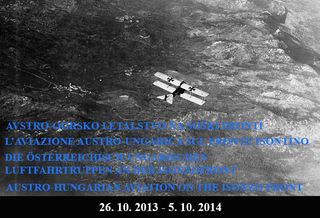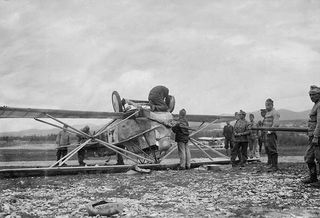Austro-Hungarian aviation on the Isonzo Front
26.10.2013 - 05.10.2014The exhibition on the Austro-Hungarian aviation on the Isonzo Front features the units and men that presented only a small portion of the great Army, gathered along the river Soča.
Towards the end of June 1915, a month after the Italian attack, the aviation arranged three airfields in the Soča region, i.e. at Ajševica, Ajdovščina and Podnanos. Flying companies 4, 2 and 12 together had 13 planes. Close to Pula operated a naval aviation airfield with five planes and in July another one in Trieste.
Two years later, in June 1917, seven airfields operated in this area on the following locations: Ajdovščina, Vipava, Podnanos, Podraga, Divača, Sežana and Prosecco/Prosek. Deployed on them were 13 aviation companies with 113 planes.
Deeper in the rear more airfields were organized with the task to operate on the Isonzo Front.
There were more numerous losses in aviation due to engine troubles and accidents on airfields than during the very combats in the air. Most often, it was the heavy NE wind bora that was fatal, and even more so was the muddy or stony karst ground of the airfields and around them.
In the first years of the war a N.C.O. piloted a two-seat aircraft, while the observation was done by a commissioned officer or (first) lieutenant. The observers were well aware that their destiny depended to a great deal on the skills of the pilots, so that some N.C.O.-pilots enjoyed great reputation. Balloon as the badge on the collars of airmen’s uniforms pointed to the history of the origin of military aviation.
With the introduction of new, single-seat aircraft, many officers wanted to become pilots and volunteered for additional training. Thus, the N.O.C.s and officers on flights became equals as fellow-combatants.
For performing reconnaissance tasks the scouts were equipped with powerful cameras. These made possible the developing of photographs from which a multitude of information about the enemy's units was obtainable while the photos were carefully studied. The value of a few of such photos and successful directing of gun shelling during an individual flight were of much greater importance for the army than the very combat efficiency of a plane.
The big and ever faster Italian Caproni bombers were equipped for defence with three machine guns, and they were also protected by an ever greater number of fast accompanying aircraft. These surpassed the efficiency of Austro-Hungarian reconnaissance “spyplanes”, so that in 1917 the latter could no longer perform independent reconnaissance flights. Italian observers announced their arrivals to Italian airmen by shooting smoke and coloured rockets from the ground and created an aerial blockade.
In the initial phase of the war, when the enemy was on an equal level and air combat was more or less an exception in which personal weapons were only used, there was still enough chance for knightly manners. Decisions were exclusively in the hands of pilots. In the years 1917 and 1918, the rapid development and mass production of aircraft, the development of arms, the use of incendiary ammunition and the dominance of one side drove them to the position which meant the end of the last “knights” and clearly announced the role of military aviation in the wars to come.


